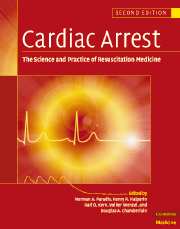Book contents
- Frontmatter
- Contents
- List of contributors
- Foreword
- Preface
- Part I Introduction
- Part II Basic science
- Part III The pathophysiology of global ischemia and reperfusion
- Part IV Therapy of sudden death
- Part V Postresuscitation disease and its care
- Part VI Special resuscitation circumstances
- 52 Prevention of sudden death in patients at risk: channelopathies and arrhythmic syndromes in the structurally normal heart
- 53 Pediatric cardiopulmonary resuscitation
- 54 Resuscitation in elder persons
- 55 Asphyxial cardiac arrest
- 56 Hemorrhagic shock and hypovolemic cardiac arrest
- 57 Cardiopulmonary resuscitation in hypothermic patients
- 58 Cardiac arrest due to poisoning
- 59 Cardiac arrest during anesthesia
- 60 Resuscitation of the pregnant patient suffering sudden cardiac death
- 61 Drowning
- 62 Anaphylactic shock
- 63 High altitude resuscitation
- 64 Electrical injuries
- 65 Rare syndromes, commotio cordis, sudden death in athletes
- Part VII Special issues in resuscitation
- Index
61 - Drowning
from Part VI - Special resuscitation circumstances
Published online by Cambridge University Press: 06 January 2010
- Frontmatter
- Contents
- List of contributors
- Foreword
- Preface
- Part I Introduction
- Part II Basic science
- Part III The pathophysiology of global ischemia and reperfusion
- Part IV Therapy of sudden death
- Part V Postresuscitation disease and its care
- Part VI Special resuscitation circumstances
- 52 Prevention of sudden death in patients at risk: channelopathies and arrhythmic syndromes in the structurally normal heart
- 53 Pediatric cardiopulmonary resuscitation
- 54 Resuscitation in elder persons
- 55 Asphyxial cardiac arrest
- 56 Hemorrhagic shock and hypovolemic cardiac arrest
- 57 Cardiopulmonary resuscitation in hypothermic patients
- 58 Cardiac arrest due to poisoning
- 59 Cardiac arrest during anesthesia
- 60 Resuscitation of the pregnant patient suffering sudden cardiac death
- 61 Drowning
- 62 Anaphylactic shock
- 63 High altitude resuscitation
- 64 Electrical injuries
- 65 Rare syndromes, commotio cordis, sudden death in athletes
- Part VII Special issues in resuscitation
- Index
Summary
Drowning refers to submersion and immersion. This chapter focuses on submersion and reviews the epidemiology, pathophysiology, and treatment of this mainly respiratory problem. Hypothermia-related immersion issues are described in Chapter 49.
Epidemiology
Circumstances of drowning vary around the world; from healthy toddlers to desperate boat refugees, and from beach to bathtub. According to the WHO report, each year between 350 000 and 450 000 persons die from drowning. In addition, in some years, over 500 000 persons have drowned in floods and tsunamis. Most drowned victims are children, and the potential years of life lost are immense. Within this global perspective, 97% of all drowning occurs in South East Asia, the Pacific, and Africa. In some areas, the drowning rate is as high as 400 persons per 100 000 inhabitants. The leading cause of drowning in these areas is multifactorial. Leisure, work, transport, and collecting water for household purposes occur in the surroundings of water. Swimming skills are lacking, as is the knowledge on how to perform rescue, first aid, or basic life support (BLS). Also, prevention efforts, rescue resources, or communication equipment are poor.
In the Western world, a combination of socioeconomic factors, legislation, multifaceted prevention programs, improved rescue techniques, and up-to-date medical systems have resulted in a 10- to 20-fold decrease in drowning rates during the last 50 years. The death rate is between 0.1 and 2.5 per 100 000 inhabitants.
- Type
- Chapter
- Information
- Cardiac ArrestThe Science and Practice of Resuscitation Medicine, pp. 1088 - 1102Publisher: Cambridge University PressPrint publication year: 2007

